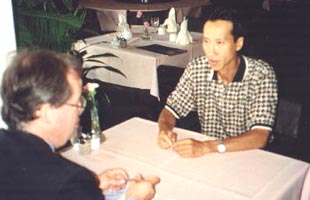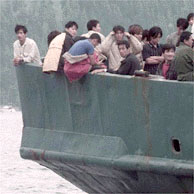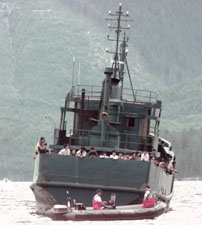
While in Victoria, August 5, CFIRC Director Paul Fromm and Webmaster/videographer Marc Lemire tracked down many of the recently released 83 Chinese illegals to the premises of the First Victoria Metropolitan United Church on whose premises are located the offices of the Intercultural Association of Greater Victoria. This  association, according to a CBC Newsworld report on August 5, had started recruiting more personnel and translators a week before knowing that the illegals would be released.
association, according to a CBC Newsworld report on August 5, had started recruiting more personnel and translators a week before knowing that the illegals would be released.
“How did this Association know the illegals would be released?” demanded Paul Fromm. “Was the fix in from the very beginning to release most of them and reward the scamsters?” The illegals, well dressed and plump, looked remarkably robust for people who had survived a recent 39-day harrowing voyage.
The illegals proved elusive and shy, trying to shield their faces from the camera. Across the street from the church where the illegals were being welcomed by elements of Canadian society, a lone homeless White Canadian was asleep on the steps of an Anglican church with his few worldly possessions and his dog. Do-gooders seemed decidedly less interested in helping Canadian homeless persons than they did in assisting the illegals. On Wednesday, July 28, many Canadians were outraged by media reports that the illegal ingrates had gone on a hunger strike to protest that fact that the special Chinese meals being delivered to them by a local caterer were not warm enough.
“Many poor and working Canadians cannot afford to eat the salmon and calamari being served these illegals,” Paul Fromm told a Victoria audience. “From people who were supposedly subsisting on rice and foul water just two weeks ago, this ingratitude to the hard-pressed Canadian taxpayer is outrageous.” An interview with Victoria restauranteur Henry Cho proved most illuminating. Cho owns and manages Ming’s  Restaurant. Opened in 1949, Ming’s is Victoria’s premier Chinese eatery and does a brisk take-out business as well. Cho, who has owned the restaurant since 1972, explained that soon after the illegals landed, he received a call from Immigration Canada asking how much notice he would require to provide 150 meals. He said 48 hours. The next day, he received a call at 7:00 a.m. asking whether he could provide 144 meals by 1:00 p.m.
Restaurant. Opened in 1949, Ming’s is Victoria’s premier Chinese eatery and does a brisk take-out business as well. Cho, who has owned the restaurant since 1972, explained that soon after the illegals landed, he received a call from Immigration Canada asking how much notice he would require to provide 150 meals. He said 48 hours. The next day, he received a call at 7:00 a.m. asking whether he could provide 144 meals by 1:00 p.m.
He did. “I had a contract to provide three meals a day for 144 people for 14 days,” Cho explains. He is adamant about the numbers, even though officially the public was told there were only 123 illegals aboard the ship. “At first,” he reports, “I was asked to serve mostly vegetables and rice, with not too much meat,” as no one knew what they had in their systems. “I was in touch with Immigration” and with the detainees, he says. “I had information on their requests and tried my best to comply.” Cho said the illegals “complained that the food was not hot enough.” This is a complaint that the experienced caterer hotly rejects. “I used tin foil containers and they can keep the food hot for almost an hour,” he said. “Then, they told me not to use the tin foil since they [the illegals] were using it for some kind of purpose.” Reports had the illegals using the tin foil and other objects as weapons which they hid. Cho then switched to Styrofoam containers.
“I found it still kept the food quite hot.” However, when the weapon-making material was no longer used, the illegals staged their brief hunger strike. “Immigration said they liked the food and had confidence in what I was serving.” Cho says: “I had a couple of requests that they’d like to have fish as they came from the coastal region of Fujian. So, I gave it to them.” Cho is cagey about the cost of feeding the illegals. He says he provided meals from his menu. “I gave them a little discount from the going rate.” Cho’s takeout menu shows dinners in the $10.00 range, before taxes. Thus, a ballpark figure for feeding the illegal ingrates would be about $60,000! Ming’s Restaurant has won the “Best Chinese Menu” award for the last five years, from 1995 to 1999 given by the Victoria News. Speaking of the complaining illegals now turned cuisine critics, a confident Henry Cho says: “If they don’t like it, it won’t bother me at all.”

DOES IT BOTHER ANYONE ELSE THAT THE IMMIGRATION AND REFUGEE BOARD’S LOGO RESEMBLES A SIEVE?
Why Are We At The Lake? I Said “The Bay”
“In an industry dominated by immigrants, the issue of English-language competency comes up again and again — most recently in Edmonton, where [cab] drivers have been told they must pass a 10-minute oral examination to renew their licenses. [Believe it or not] … in Vancouver there’s been a bylaw for at least a decade that taxi drivers must speak, read and write English. A similar rule in Toronto has been in place since at least 1993.” (Globe and Mail, June 14, 1999)
How Do You Say “Thank You” In Albanian? “I am informed that most of these people want to return to their country as soon as possible.” (Lucienne Robillard, April 30, 1999) “Citizenship and Immigration Canada will provide the following assistance to all refugee families from Kosovo for up to 24 months from the date of arrival in Canada: financial assistance to meet basic food, shelter and clothing needs (rates based on provincial social assistance rates); financial assistance toward the cost of essential household goods, working tools and employment-related examinations; hospital, medical and dental care … and language testing and training.” (Sponsorship of Kosovar Refugees, Citizenship and Immigration Canada FACT SHEET, June 11, 1999) “So far, only two of the 900 Kosovo refugees in B.C. have officially applied to go home.” (CBC Newsworld, July 9, 1999) Of the first group that did go back: “while some of the refugees came with nothing, they checked [out] today with overflowing bags.” (CBC Newsworld, July 7, 1999) Nevertheless, Toronto’s “Albanian and Muslim leaders say they are upset and frustrated with the way Kosovar refugees have been handled in Canada. … ‘Many left (Canada yesterday) in a terrible mood,’ said Halit Hoxha, president of the Albanian Community Association. …
Their charges include: Clothing being distributed to Muslim women that doesn’t respect their modesty. … ‘We have the biggest Muslim community in North America here, but the refugees aren’t being sent here,’ said Abdallah John, a local Muslim who has visited the camps. Immigration spokesperson Rene Mercier said refugee families are being sent to specific communities based on local services, job opportunities and cost of living. If they choose to go elsewhere, they will not have a sponsoring family to help them adjust to life in Canada, he said.” (Toronto Star, July 8, 1999) If Toronto is the largest Muslim community in North America, why are ‘sponsoring families’ located elsewhere? One of these, “a Calgary man who just said good-bye to a family of Kosovar refugees said the experience has left him bitter and wondering why he ever offered to help. …
Gary Moore, 47, said he has sponsored several refugees wanting to start a new life in Calgary. But he said the group he dealt with from Kosovo were demanding and sullen. ‘They felt the world owed them,’ Moore  said. … ‘When we started to load their mountain of luggage, they stood back and let us do all the work,’ Moore said. Moore took the family to the southeast Ogden area where three apartments [freshly painted with new furniture and dishes] had been found for them to live in. … They said ‘This is not suitable. Where’s all the other Kosovars we’re supposed to be living with?’ Eventually they all [12] wound up living in the same apartment and not using the other two. On July 26, the family left Calgary, after hostilities ceased in Kosovo.
said. … ‘When we started to load their mountain of luggage, they stood back and let us do all the work,’ Moore said. Moore took the family to the southeast Ogden area where three apartments [freshly painted with new furniture and dishes] had been found for them to live in. … They said ‘This is not suitable. Where’s all the other Kosovars we’re supposed to be living with?’ Eventually they all [12] wound up living in the same apartment and not using the other two. On July 26, the family left Calgary, after hostilities ceased in Kosovo.
Moore said he was disgusted to find that before leaving, the family sold their household items that had been provided by the Canadian government.” (Calgary Herald, July 30,1999)?????



Illegal Entry: What Next – Water Wings? “In the fall of 1997, RCMP and federal customs and immigration officials foiled an organized crime unit’s attempt to smuggle 22 Chinese into Iqaluit [what was once Frobisher Bay] via the Greenland city of Nuuk. Tipped off by their phoney Japanese passports, officials stopped the would-be refugees from boarding the airplane in Nuuk.  [Presumably then, as usual, it was a foreign police agency that foiled the attempt]. ‘I think the 22 that tried to come in 1997 is proof that organized crime is looking for the path of least resistance into Canada, and they perhaps see Iqaluit as part of that path,’ said Sergeant Lindsey Brine of the RCMP’s V Division headquarters in Iqaluit.” (National Post, May 27, 1999) However disturbing you may find this systematic groping and palpation of Canada’s frontiers, Ottawa’s invariable response is to giggle and shriek with the excitement of it all.
[Presumably then, as usual, it was a foreign police agency that foiled the attempt]. ‘I think the 22 that tried to come in 1997 is proof that organized crime is looking for the path of least resistance into Canada, and they perhaps see Iqaluit as part of that path,’ said Sergeant Lindsey Brine of the RCMP’s V Division headquarters in Iqaluit.” (National Post, May 27, 1999) However disturbing you may find this systematic groping and palpation of Canada’s frontiers, Ottawa’s invariable response is to giggle and shriek with the excitement of it all.
But Didn’t You Just Prove That You’re A Big Girl? Quebecer Fritz Mathieu and a Japanese woman began dating in 1996. And then an almost unbelievable thing happened — are you sitting down? — she became pregnant. Mathieu said he had no wish to marry and suggested she get an abortion. She went home to give birth, but bounced back here a month later. So far, her “bid to stay in Canada to protect her newborn baby from racial discrimination back home has failed.
She must now be out of the country by Aug. 11. Yuki Iwai, 28, says her six-month-old son by a Canadian would be thought of as a foreigner because of his mixed-race background, despite being born in Japan. ‘My parents didn’t tell anybody about (my situation),’ Iwai said, because of the shame of single motherhood and the baby’s ethnicity. If she could stay, her child’s life would be much better, she said. [That’s right. No point enlightening your own society] … Her lawyer Peter Wong says Iwai’s last hope is for Calgarians to ask the new minister of citizenship and immigration, Elinor Caplan, to make an exception in this case. ‘We hope people will feel a sense of compassion for Yuki’.” (Calgary Herald, August 4, 1999) Don’t hold your breath.
How About A Convention On The Rights Of The Taxpayer?  In July, the top court “ruled that the interests of Canadian-born children should be considered when their parents are ordered deported. The case involved [Mavis Baker] a 44-year-old Jamaican woman who arrived in Canada in 1981. She overstayed her visa and was considered illegal soon after she arrived, but her deportation was not ordered until 1992, by which time [the diagnosed schizophrenic] had four Canadian-born children. Her lawyers argued successfully that deporting her in 1999 would violate the United Nations Convention on the Rights of the Child, which states that children should not be separated from their parents unless it is in their best interest.
In July, the top court “ruled that the interests of Canadian-born children should be considered when their parents are ordered deported. The case involved [Mavis Baker] a 44-year-old Jamaican woman who arrived in Canada in 1981. She overstayed her visa and was considered illegal soon after she arrived, but her deportation was not ordered until 1992, by which time [the diagnosed schizophrenic] had four Canadian-born children. Her lawyers argued successfully that deporting her in 1999 would violate the United Nations Convention on the Rights of the Child, which states that children should not be separated from their parents unless it is in their best interest.
The woman, now on welfare, says she has nothing to return to in Jamaica [apart from an earlier batch of four kids she left there. Presumably they and their families are now eligible to apply under family reunification].” (Migration News, Vol. 6, No. 8, August 1999) When Baker’s immigration officer wrote up the case (six years ago), he was so frustrated that he resorted to capitalizing the important parts in hopes that someone might notice: “This case is a catastrophe. It is also an indictment of our ‘system’ that the client came as a visitor in Aug. ’81, was not ordered deported until Dec. ’92, and in APRIL ’94 IS STILL HERE!” (Toronto Star, July 14, 1999)
“Canada” Day Feel Good Story  “Three of the four Filipino sailors of the Maersk Dubai … have been reunited with their families in Halifax. … On Wednesday, Rev. Flemming Holm, who speaks for a group formed to defend the seamen, said the first three families arrived in Canada in February but it wasn’t made public for fear of too much publicity.” (CBC Newsworld, June 27, 1999) This previously unsuspected modesty marks a sea change for the gentlemen who never appeared on camera unless their faces were contorted by wracking sobs. The crying game commenced when they defied a court order to testify in the case of the Romanian stowaways and they were still weeping as they defied their final deportation orders. Naturally this unvarying refusal to obey Canadian law ultimately won them (and their families) admission on compassionate grounds. To the best of our knowledge, Canada is the first country to recognize compulsive crying disorder.
“Three of the four Filipino sailors of the Maersk Dubai … have been reunited with their families in Halifax. … On Wednesday, Rev. Flemming Holm, who speaks for a group formed to defend the seamen, said the first three families arrived in Canada in February but it wasn’t made public for fear of too much publicity.” (CBC Newsworld, June 27, 1999) This previously unsuspected modesty marks a sea change for the gentlemen who never appeared on camera unless their faces were contorted by wracking sobs. The crying game commenced when they defied a court order to testify in the case of the Romanian stowaways and they were still weeping as they defied their final deportation orders. Naturally this unvarying refusal to obey Canadian law ultimately won them (and their families) admission on compassionate grounds. To the best of our knowledge, Canada is the first country to recognize compulsive crying disorder.
Oh, You Mean Decorum For Us! Following an unsatisfactory outcome to her immigration hearing, an independent Chinese immigrant took the decision of Canadian visa officer, Susan Barr, to Federal Court. Justice Yvon Pinard found “Barr’s comments about the applicant’s ‘numerous loud sinus noises’ during a selection interview created the appearance of bias on her part. … In an affidavit, Ms. Barr said she was only doing her duty as a visa officer in noting Qin Zhao’s sinus trouble in June, 1998, since all observable health problems must be assessed by Canadian medical staff. … But Ms. Zhao, a 35-year-old engineer from China, said Ms. Barr was angry and impatient as she demanded to know ‘why so many Chinese people have bad breathing habits.’ … Judge Pinard found that Ms. Barr, regardless of her intentions, failed to maintain an appropriate level of decorum [and] … ordered federal immigration officials to reconsider the application.” (National Post, July 12, 1999)
Isn’t “Tolerance” Fun? Toronto resident Elizabeth Ann Magner is being pilloried for filing a suit alleging that “smells emanating from the kitchen of Tung Chu Huang and Tzu Chun Huang are interfering with the enjoyment of her home, and may even be giving her cancer. … The lawsuit cites a study of Asian women in Taiwan to support its claim that the cooking smells may cause lung cancer, said Roslyn Tsao, the lawyer [working free of charge] for the Huang family. … Neighbours held a news conference yesterday to say they think the suit stinks of cultural intolerance. … ‘As their neighbours, we have to gather together and let members of this family know they are not alone,’ [Winnie Yao] said. … Philip Tsui, president of the Chinese Canadian National Council’s Toronto chapter [said] … the outcome of the case will affect not only the 380,000 Chinese Canadians in Toronto. … ‘This opens the floodgates for all sorts of litigation.'” (Globe and Mail, July 28, 1999) Meanwhile, “every night [since April] the residents of a mainly Chinese neighbourhood in Richmond, near Vancouver, gather to protest the arrival of the Turning Point recovery home.
The facility houses as many as 10 male addicts learning to live free of alcohol or drugs. … Their lawns are covered with indignant slogans about the threat to children and the affront to democracy. … ‘Help! Help!’ reads one protest sign carried by a child. ‘I’m scared to play outside now! Who can help me?’ … Newspaper letter writers have accused the residents of being selfish, isolationist and lacking in compassion. Residents from the neighbourhood where the Turning Point used to be signed a petition of their own calling the centre’s inhabitants ‘always respectful and quiet’. When Richmond Mayor Greg Halsey-Brandt feared the strife was beginning to form along racial lines he formed an ‘integrated service team’ to resolve the dispute. … The residents refused to join. … ‘We don’t want to give up,’ one of the protesters explained. ‘We want to keep up the pressure because we believe eventually they’ll have to move.'” (South China Morning Post, July 16, 1999) Driving away the undesirables is getting to be a recurrent theme. The nominally Christian Chinese Co-ordination Centre of World Evangelism’s January 1996, Chinese Around The World notes: “In the 1970s, Richmond was a rustic place … [now] many older residents lament the loss of the community with which they grew up; sometimes they have found themselves the only non-Asian in their street. But, homeowners have undoubtedly benefited from skyrocketing property prices, making the option to move out a lot easier to take. …
Two years ago, the Hongkong-style Aberdeen shopping mall came under attack because some shops displayed Chinese-only signs and some shopkeepers were less-than-welcoming to non-Chinese customers. … Richmond’s Caucasian children occasionally find themselves the only white faces in classrooms. In the case of a class where Cantonese was the main conversation language, they are practically shut out of classroom life. … This year, a controversy erupted over a proposal by a number of Chinese parents for an Asian-only parents association for the school system. … Such incidents have led some Richmond residents to move their homes to other towns nearby. Lilian To, Executive Director of ‘Success’, the immigration-assistance group, notes that those Richmond expatriates want to be with their own group, too. She asks, ‘How is it different than some Chinese people who want to be with other Chinese people?'” Let’s ask NATO if ethnic cleansing’s a sin. It all depends: who’s moving out, and who’s moving in?

Child Molesters? No Problem — Everybody Gets In! Forty-four year old Walter Gonzales Toledo, “a convicted child molester deported to Guatemala two years ago was allowed to return to Canada because his lawyers were arguing he had successfully completed treatment to control his sexual attraction to children. … The decision by Judge Karen Sharlow means Toledo will now be allowed to remain in Winnipeg. … At the hearing, [his lawyer, David] Matas argued that Toledo had been successfully rehabilitated and was the sole provider for his Canadian wife and their two children. The family, Mr. Matas said, would be forced onto welfare without Toledo’s salary as an outside worker for the City of Winnipeg. … ‘This case is unusual in that they removed the guy, and he was brought back specifically for the appeal … and then he won his appeal,’ Mr. Matas said from Winnipeg. … But federal statistics would suggest about half of all deportation appeals are successful. According to Citizenship and Immigration Canada, the immigration board’s appeal division handled 1,464 deportation appeal cases last year. Deportation orders were stayed in one-third of the cases and overturned in another 18%. Appeals were dismissed outright about a third of the time; the rest were withdrawn or abandoned. … The Immigration Minister can limit a criminal’s right to appeal by declaring the individual a ‘danger to the public,’ but that power was not used in the Toledo case. The [unlamented] Ms. Robillard used that authority to deport [a grand total of] 236 people last year.” (National Post, August 2, 1999)
Loads Of Fun With Novelty Refugee Claims! This is essentially a story of bad timing. Had all this happened this year, Canada would have doubtless embraced Albanian Ardian Feimi and his barbarous blood code as a source of desperately needed diversity. In 1996, the Feimi family were enjoying themselves on the Greek Island of Hydra — until the Feimi sister was allegedly accosted there by a chap named Gjoni. Naturally, this kind of grave insult required Ardian’s brother Niko, to stab Gjoni to death. “According to his claim for refugee status in Canada, Mr. Feimi, [that’s the murderer’s brother, Ardian] 28, is the target of a blood feud sanctioned by the strict code of Prince Leke Dukagjini, a 15th-century Albanian ruler. The code demands that Mr. Feimi — or one of his siblings — be killed by the [Gjoni] family. …
The Law of Leke records ancient Albanian customs that govern everything from marriage to public meetings to blood feuds. Earlier this century, it was estimated that blood feud killings accounted for 30% of all male deaths in Albania. … Feimi came to Montreal with the help of [what else?] a Canadian he met in Greece and claimed refugee status in June, 1997.” (National Post, June 28, 1999) The IRB rejected his claim a year later, as has the Federal Court. Yet, all is not lost: Feimi is asking immigration authorities to give him a break on humanitarian and compassionate grounds.
Not If I Sue You First! “A Haitian immigrant who arrived in Canada in 1973 and sponsored the admission of 12 relatives, eight of whom went on welfare, is suing Quebec in an effort to stop the Quebec government from collecting $71,000 in welfare payments from her, saying that she did not understand what she was signing when she sponsored their admission. … Between 1987 and 1995, Quebec made $237-million in welfare payments to recent arrivals who should have been looked after by their sponsors. … According to one estimate, about 15 percent of family-class immigrants rely on welfare within a decade after their arrival.” (Migration News, Vol. 6, No. 8, August 1999)
And Now, A Word From Our Sponsor A report by immigration official Alain Gingras, has been widely circulated in the immigration department, where it has fallen on the usual deaf ears. “In his report’s preamble, Mr. Gingras states that he felt the survey was needed because he had seen abuses of our system while he was a visa officer in Sri Lanka from 1996 to 1998.
People sneaking into Canada under false pretences, pretending they were landed immigrants in order to become fake refugees, was such a problem that anyone flying to Canada had to first appear at the High Commission to have their documents checked and to be interviewed in order to make sure they were bonafide Canadian permanent residents. Gingras inspected and interviewed 1,000 of these people and was shocked to find that the majority of them who were living in Canada had been sponsored and were living off welfare. … He sent out a separate survey to 247 sponsors asking for more information than is normal. … [Sponsorship eligibility is calculated according to an arcane system that allows the sponsor to pick and choose supporting documents] … For instance, a taxi driver can claim to have an income of $40,000, but his expenses may be $20,000, thus putting his income level too low to sponsor.
A relative or accomplice can pose as an employer and write a letter or provide a phony T4 slip. Even if the sponsor has a good, proven income, the department fails to take into account the fact that the sponsor may have a large family to support on that money, thus putting his remaining income level too low to sponsor others. … ‘Thirty-four percent of Sri Lankan sponsors who are approved are, in fact, incapable of supporting the sponsored persons. Can this proportion be extended to sponsors of other nationalities?’ he asks. ‘There is no reason to think that sponsors of any other national origin have a different experience.’ …
In my opinion, sponsored immigrants should not be a cost to the health care, education, pension, or welfare systems. Sponsors should have to post a bond in case they fall on hard times and their relative should be sent back immediately if there’s a problem supporting them. This study reveals, once again, that immigration officials are not doing their jobs properly. Canada has allowed 238,911 relatives to be sponsored here between 1989 and 1998 [people who otherwise could not get in]. How much in welfare has this cost us? In public housing? In pensions? In gigantic health care costs for the grandparents and parents that we never should have incurred? … As immigration officials leak this and other items to me out of sheer frustration, it’s becoming more and more evident that immigration, Canadian-style has impaired our economy and cost taxpayers needless billions.” (Diane Francis, Financial Post, May 8, 1999)
Immigrants Want Less immigration? Given the number of people directly or indirectly feasting at the immigration ulcer, how strange to think that those in favour of more immigration, are now proportionally fewer than the actual immigrant presence. In terms of annual intake, Immigration Canada’s “long-range policy intends to increase that to 300,000, nearly three times the per-capita rate of the United States. … 41% of those surveyed by [a TIME/Environics] poll want to see fewer immigrants arriving in the next century, and only 14% hope to see more.” (National Post, May 25, 1999) In the last census, “immigrants represented 17.4% of the population.” (Statistics Canada, 1996 Census: November 4, 1997)
